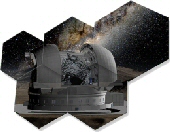Italiano:
Ancora una immagine dalla sessione di riprese del 18 ottobre scorso, questa volta centrata sul bellissimo cratere “Pythagoras” in condizioni di piena illuminazione solare, un cratere da impatto di 130km di diametro e 5 km di profondità, situato nella estrema parte nord occidentale della Luna.
Il suo aspetto, dal nostro punto di vista terrestre, è perennemente ovale e solo la parte più occidentale di esso può essere osservato da Terra, mentre la parte orientale è a noi perennemente nascosta alla nostra vista.
Al centro di esso si trova un doppio picco centrale, molto ripido, che si eleva dalla base per 1,5 chilometri in altezza. Il bordo di Pitagora, molto ben conservato, ha un ampio sistema di terrazze e un leggero bastione attorno al bordo esterno. Sebbene generalmente circolare, il contorno del cratere ha una forma tendenzialmente esagonale, come molti altri grandi crateri da impatto. Il fondo di esso appare appiattito, ma con una superficie irregolare e a tratti collinosa mentre ci sono evidenze di frane intorno al bordo del cratere.
Tra i crateri visibili in questa immagine, ve ne sono un paio visibili da Terra solo in particolari periodi di librazione lunare (quando cioè la Luna, durante il suo percorso di rivoluzione intorno alla Terra, rende visibili piccolissime porzioni estreme, lungo i bordi di essa), come i crateri “Cleostratus”, “Boole” e “Cremona” tutti e tre crateri moto antichi con margini molto erosi.
Di questi ultimi il cratere “Cremona” (diam. 85 km.), che fu intitolato al matematico italiano Luigi Cremona, ha diversi altri crateri minori sovrapposti ad esso, con le pendici interne inusualmente ampie verso ovest, digradanti nel pianoro interno che assume un aspetto accidentato. Nella porzione orientale di esso, l’interno è più regolare e contiene i resti di un picco centrale vicino al margine orientale del piccolo cratere Cremona C.
Grazie per la Vostra attenzione!
e… ad maiora semper… 😉
Dettagli tecnici:
Telescopio Astrofaktoria DK20 @ ~ F/17 – Baader FFC Multiplier – Baader IR 685nm filter – GS3-U323S6M-C camera – Seeing 6/10 in IR band – sito: Palermo @ my personal Observatory.
English:
Another image from the capturing session of last October 18, this one centered on the beautiful “Pythagoras” crater in conditions of full sunlight, an impact crater 130km in diameter and 5 km deep, located in the extreme north-western region of the Moon.
Its aspect, from our terrestrial point of view, is perennially oval and only the most western part of it can be observed from Earth, while the eastern part is always hidden from our view.
At the center of it there is a double central peak, very steep, which rises from the base for 1.5 kilometers in height. The edge of Pythagoras, very well preserved, has a large system of terraces and a light bastion around the outer edge. Although generally circular, the contour of the crater has tendentially an hexagonal shape, like many other large impact craters. The bottom of it appears flattened, but with an irregular surface and sometimes hilly while there are evidences of landslides around the crater rim.
Among the craters visible in this image, there are a couple of them visible from Earth only in particular lunar libration periods (when the Moon, during its path of revolution around the Earth, makes tiny extreme portions visible along its edges), like the “Cleostratus”, “Boole” and “Cremona” craters, all three ancient craters with very eroded margins.
Of the latter, the “Cremona” crater (diam. 85 km.), Which was named after the Italian mathematician Luigi Cremona, has several other minor craters superimposed on it, with the inner slopes unusually wide towards the west, sloping down into the inner plateau which assumes a bumpy look. In the eastern portion of it, the interior is more regular and contains the remains of a central peak near the eastern edge of the small crater Cremona C.
Thanks for your attention!
and “ad maiora semper“… 😉
Technical details:
Technical details:
Astrofaktoria Telescope DK20 @ ~ F / 17 – Baader FFC Multiplier – Baader IR 685nm filter – GS3-U323S6M-C camera – Seeing 6/10 in IR band – site: Palermo @ my personal Observatory.


